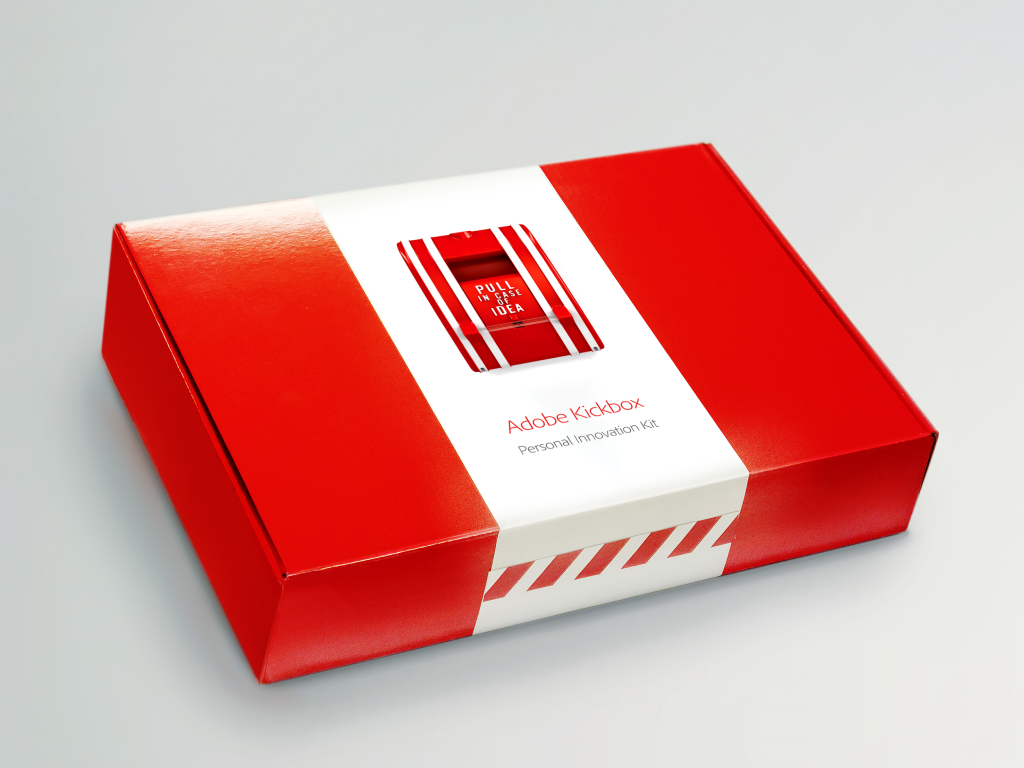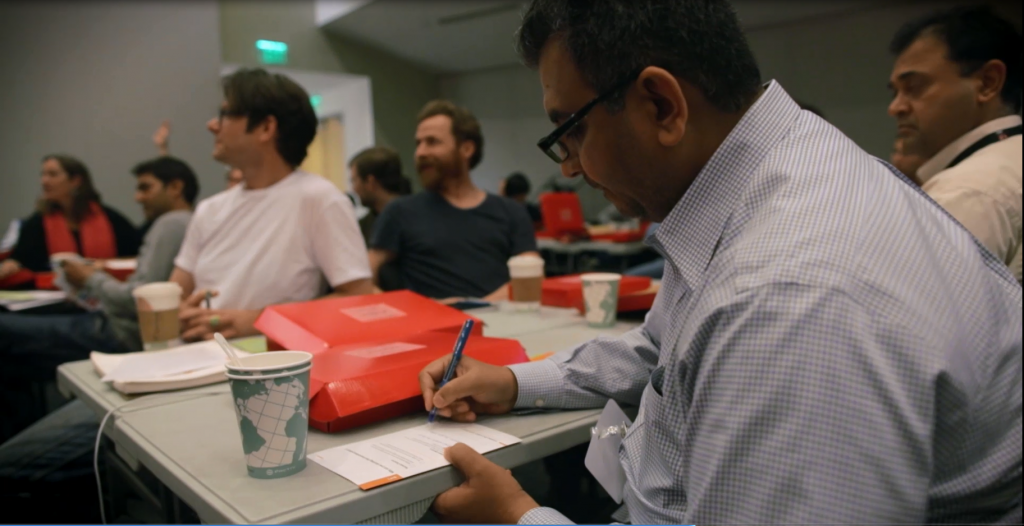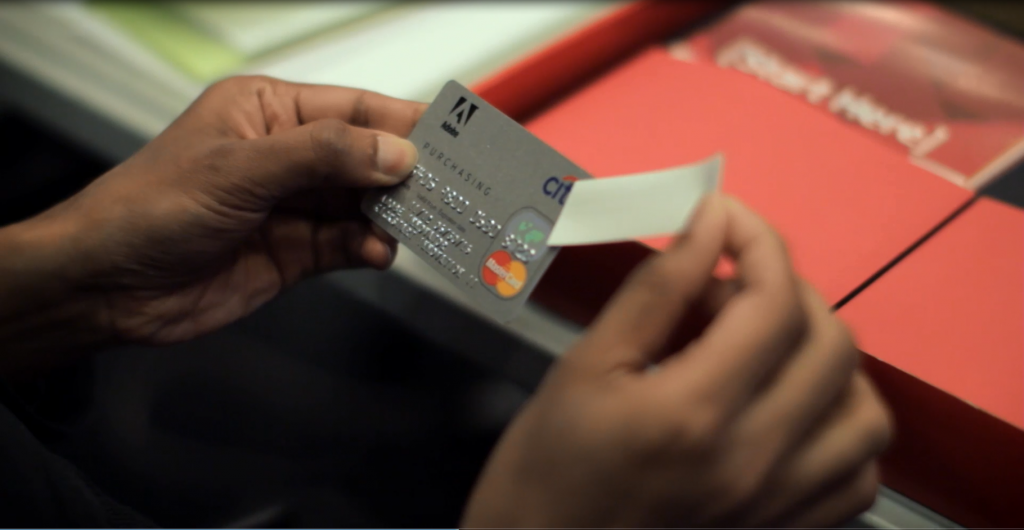Can you let your employees take charge of innovation – with little managerial oversight? When employees are empowered to make a difference on their own – to lead rather than follow a managerial directive – the innovation process takes on a life of its own.
Adobe Kickbox, a physical box of practical tools and resources for employees to innovate rapidly and independently, fosters innovation in every pocket of the company. It helps capture grassroots innovation happening at the edges of the internal network.
At more than 11,000 employees, Adobe is a large software company in the heart of Silicon Valley. Such companies can struggle to keep talent when the best and brightest are often lured away by promises of lucrative start-ups and entrepreneurship. By focusing on fostering intrapreneurship in its employee base, Adobe offers the empowerment needed to keep staff engaged and challenged while directly contributing to product R&D and company growth.
Although today Adobe Kickbox can be used by any company, it originally began as the sole innovation process used at Adobe since 2012.

Since its inception, more than a thousand new ideas have been prototyped using the Kickbox process. Once Adobe realised the potential for Kickbox to support innovation in all companies, it began offering its resources free for download at Kickbox.Adobe.com. Thousands of companies and organizations have already downloaded the kit in multiple languages.
What, exactly, makes Kickbox so different and so successful? Adobe Kickbox pulls employee innovation out of people’s brains and into action, using the following tools in a training session:
- Prepaid credit card with $1,000 for project research and proof-of-concept (empowerment)
- Starbucks gift card (caffeine)
- Chocolate bar (sugar)
- Complete directions for Adobe’s innovation process (some structure)
Once an Adobe employees completes the final phase of the innovation process directions, they’re then awarded a “Blue Box” (with its secret contents undisclosed) and assigned an executive sponsor to bring their ideas to fruition. Your guess is good as mine, as what’s in there – but that desire to get to the next level will drive motivation.
How to ensure quality ideas while still “failing fast”
The goal of the Adobe Kickbox innovation process is to increase the rate of failure by making small bets on ideas in a really fast, decentralized way. It intentionally “breaks” all of a company’s processes and requires leaders to completely rethink their innovation funnel. But, in the end, it will result in diverse ideas and products that customers actually want. To fail fast, employees follow the Kickbox’s six steps to innovation.

- Inception. Motivating Innovation of new ideas.
- Ideate. Brainstorming to come up with new ways to help customers and employees.
- Improve. Polishing Ideas to refine before taking to market.
- Investigate. Talk to customers and test directly. (This is often where the $1,000 prepaid card comes in, as employees create a proof of concept to show that customers would want and adopt their idea. This may include advertising, A/B testing, or hiring the crowd to build a prototype.)
- Iterate. Evolve hypothesis based on findings from the investigation.
- Infiltrate. Pitch to management. (The final pitch in step six must end with a request for money – budget/resources – in order to secure c-suite commitment. Those with hard numbers from the tests stand to gain more traction)
Using this process, Kickbox teaches people to innovate when there is no innovation programme within the company. It requires no infrastructure, no leadership review and deliberation, and comes with complete directions. To ensure quality of ideas, Adobe also requires employees utilizing Kickbox to first attend an instructional class, a foundational course many other companies have since replicated.

Kickbox innovation requires complete commitment, even to points of contention
In order for Kickbox to be successful within an organisation, companies must adopt the six-step process fully, without exception. In a Crowd Companies innovation council call, Mark Randall, VP of Creativity at Adobe, shared three big points of contention that companies most struggle with in Kickbox adoption:
- It must be open to all employees. Kickbox won’t be successful if it doesn’t embrace the fact that a good idea can come from anywhere, in any department, not just marketing or product development.
- Employees are empowered to pursue any idea. The empowerment for all employees to explore democratises innovation and puts trust into action.
- Intrapreneurs must receive “no-look funding” in the amount of $1,000. This is a critical part of the “special sauce” that makes Kickbox successful. It’s a significant risk to invest in ideas blindly, but Adobe found that people spent their money much more carefully than they did using normal budgetary allocation.
Kickbox inspires profound changes in employee behavior and their relationship to the company. You can download Adobe Kickbox here to begin the full innovation process today.
I’ve worked with Adobe for many years, and they’re currently a customer of my company, Crowd Companies, an innovation council.
chrisharry1@mail.postmanllc.net